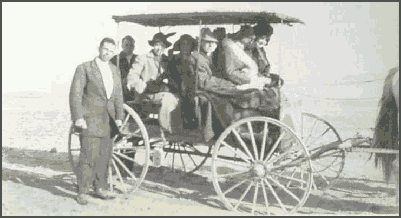
and
The Corwin Ranch

and The Corwin Ranch |

Elmore told his daughter Elma that the key to their success on the desert was finding water at a reasonable depth. Fortunately they had the experienced advice of the Nation family, who lived about a mile away, but still, you can imagine the amount of anxiety the Corwins felt until the water table was established with a physical well in place.
With the help of Frank Cook, an African-American who lived close by in the Bell Mountain District, Elmore dug a well and struck water at 101.2 feet. He then constructed a windmill. In 1917, about the time of Elmore's 70th birthday, the well was deepened and a new pumping plant installed.
The wells in this area were measured for an engineering study in 1917, and the Nation well had water standing at 108 feet below the surface. George Holbrook had the shallowest ground water in the immediate vicinity, the water standing at 72.8 feet in one of his wells, and at 80.0 in another. This was the purest, sweetest water that many people had ever tasted, and when Apple Valley Ranchos started decades later, people were still praising the water.
Unfortunately it was all too common to have problems with wells: they silted in, or the water table dropped, or any number of technical difficulties could arise. The Corwins had to dig a new well in 1920, this time going clear down to 150 feet. Another new pumping plant was required, and even a new windmill. The original windmill had "poked its nose into the ground on July 1st, making a complete wreck of itself." Elmore amazed the community when he continued through the years to scamper up the steep ladder of the windmill, even at the age of 90, to grease and adjust it.
Five years later the well had to be deepened again, but this was when additional land was brought under cultivation. The irrigation pump on the well was powered by an engine that ran a fuel oil called distillate. The ranchers ordered the fuel in barrels, which were shipped by rail to the depot, and then hauled to the ranches by horse-drawn wagons.

Water was not the only thing in the ground that interested Elmore. He had written the Land Office in January 1911 with several inquiries, primarily regarding mining claim rights versus homesteader rights. One question reads, "Can an association of eight people enter or locate a 160 acre placer claim upon which an individual claim of 20 acres had been previously located and dispossess said individual claimant."
He also asked, "Should mineral or oil be discovered on a person's homestead or desert claim prior to the obtaining of a patent thereto, would a placer claim to said lands take precedence and dispossess said agricultural entryman. If so would the person so dispossessed lose his homestead rights?"

The nature of these questions reveals that Elmore, like many of those who came to the desert before him, was taken with the idea of striking it rich with a mineral discovery. The Land Office counsel responded by sending a copy of Mining Laws and Regulations with appropriate sections marked, and with references to various legal cases on the question of location of placer claims.
The final sentence was particularly sobering: "You are further advised that if a homestead or desert land entry is found to contain a valuable mineral [including oil] deposit prior to final entry, [it] must be canceled...." Whatever Elmore and his seven companions were up to, that statement must have given them pause.

 PAGE
1|
2|
3|
4|
5|
6|
7|
8|
9|
10
PAGE
1|
2|
3|
4|
5|
6|
7|
8|
9|
10

